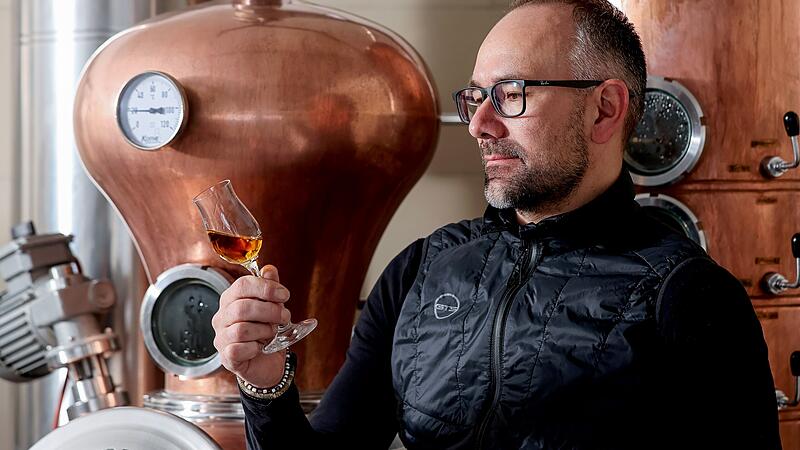
At the Gumpenberger-Hof in Altenhofen, a small hamlet in the municipality of Sarleinsbach, schnapps has always been distilled. The grain distilling law goes back to the 19th century. “It used to be more of a technical distillation, as was common in agriculture,” remembers Helmut Gumpenberger, who runs the organic farm in the heart of the Upper Mühlviertel together with his wife Regina. Quantity often came before class. “Is something going down anyway?” was the overriding concern when heating the boiler. As farm takeovers, the Gumpenbergers initially devoted themselves to dairy farming – as a sideline. Distilling schnapps and beekeeping were also part of it. The last cattle left the farm in 2015 and the focus was on organic niche products such as honey and hard liquor. “The more I worked on it, the more the quality came to the fore.” After many attempts, the first whiskey finally matured in the barrels. “Honky” was born from honey and whiskey. In 2016 the old distillery was replaced and the fine distillates took up an ever larger part of the business.
It starts with mashing
“Distilling schnapps begins with mashing,” says Gumpenberger. The foundation for future quality is already laid when selecting the fruit. “Clear fruit has no place in the mash.” A principle that, of course, does not seem compatible with the rural distilling of grandfather’s time. “But it’s when you’re mashing that you decide everything. The distilling itself is more of a technical process,” says the award-winning distiller, who now produces 25 products. In addition to apple, pear and plum brandies, Gumpenberger also distills whiskey, rum and gin. The expectations of the crowd are also different than in the old days. “The smallest batch for me is around ten to 15 liters.” You have to know exactly what’s going on in the mash: “You almost have to be a molecular biologist to know when which substances are created in the mash,” says Gumpenberger and philosophizes about alcohols and esters, which are responsible for the different flavor nuances. You’ve never stopped learning: “I keep getting to know extremely good distillers who have enormous knowledge,” he says. Intuition is also important, and ultimately a bit of luck helps to produce such good brandies. The quality can be seen and, above all, tasted. The Honky was already one of the best whiskeys in Europe last year.
The honky world of experience
With the success came increased interest in the company itself: “Customers want to know where the products come from and always wanted to visit us. That’s why we created the Honky Experience World,” says Gumpenberger. At the beginning of the tour, the people of Mühlviertel give the guests an insight into the history of the distillery’s origins and inform them about product development and the biological cycle at the family business. This all happens in the converted cattle stable. Equipped with knowledge about the raw materials, the guests start the tour in the mash cellar, where the basis of the products is laid. Here you can find out how the raw materials are transformed into alcohol. In modern distilleries, the head distiller himself usually explains how the spirits are made. A highlight is the barrique barrel storage, where the distillates get the finishing touches through years of storage. Gumpenberger gets these barrels himself from Alsace, France. “I select the barrels, smell them and then decide whether they are suitable.” These are barrels in which sherry had previously matured. New barrels would be completely unsuitable for Gumpenberger’s use. The highlight of every tour is the tasting in the Honky presentation room, which is only separated from the barrel warehouse by a glass wall and is characterized by granite and stone walls.
www.honky.at
Helmut Gumpenberger, Honky founder, on the process that transforms fruit or other raw materials into alcohol
My themes
For your saved topics were
new articles found.

info By clicking on the icon you can add the keyword to your topics.
info
By clicking on the icon you open your “my topics” page. They have of 15 keywords saved and would have to remove keywords.
info By clicking on the icon you can remove the keyword from your topics.
Add the topic to your topics.
Source: Nachrichten



